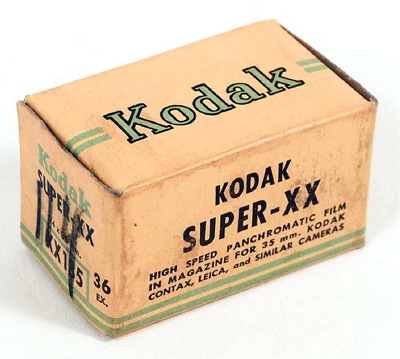 [Editor’s Note: Combat veteran and amateur military historian Charles Herrick’s crucial earlier posts in this series corrected 70 years’ worth of miscaptioning of one of Robert Capa’s ten D-Day photographs from Omaha Beach, and pinpointed the exact location and approximate time at which he landed on the Easy Red sector with a later wave.
[Editor’s Note: Combat veteran and amateur military historian Charles Herrick’s crucial earlier posts in this series corrected 70 years’ worth of miscaptioning of one of Robert Capa’s ten D-Day photographs from Omaha Beach, and pinpointed the exact location and approximate time at which he landed on the Easy Red sector with a later wave.
In this new article, Herrick, at my request, performs a deep dive into the military records in order to “follow the film” — that is, to detail the logistical steps through which Capa’s D-Day exposures moved through the system from the moment Capa re-boarded the USS Samuel Chase after leaving Easy Red until the moment they got delivered to John Morris at LIFE‘s London office on the night of June 7, 1944.
Bits and pieces of the journey these films made have appeared in previous posts by Herrick and myself, but never connected as a coherent narrative. We believe that tracking them all the way from the beach to Morris’s hands sheds considerable new light on the situation, and on the myth.
Part 3 appears below; click here for Part 1, here for Part 2, and here for Part 4. — A. D. C.]
•
Follow the Film (continued)
by Charles Herrick
… As a general protocol, LIFE assistant picture editor John Morris would have taken routine film to the censors’ office after developing, for clearance. When it came to top-secret film, he would have received the surviving film after the laborious assessment process described earlier (see previous post), but after editing and preparing it for shipment he would still have to pass the film packet by the censor one last time to clear it for the Preswick flight that would take it to the U.S. and LIFE‘s home office in New York.
With that as background, and by closely parsing Morris’s version of the tale, we may be able to draw a likely conclusion regarding the censors’ initial decision on handling Robert Capa’s D-Day film. In his Jozefa Stuart interview,[1] Morris claimed he had Capa’s film in hand at 2130 hours (changed to 2100 hours in later retellings[2]), and “When the negatives came out of the soup, Hans Wild said these pix are fabulous.” But then, oddly enough, Morris stated it was not until “midnight or 1 o’clock [that] Dennis came running upstairs” to say the film was ruined. [Editor’s note: This was the teenage “darkroom lad” eventually identified as Denis Banks, on whom Morris blamed the supposed darkroom disaster for decades. — A.D.C.]
We know that the darkroom-accident story is technically impossible, so this anecdote with “Dennis” is unlikely, to say the least. And now we have another red flag. That timeline doesn’t make sense; 2½-4 hours (depending on which of Morris’s variations we accept) is far too long for merely developing two rolls of 35mm film,[3] assuming that it was handled routinely as secret material. Something else must have happened during that period, something that entailed more steps and more stringent handling.
So let’s consider the other alternative: that all of Capa’s D-Day film was reclassified as top secret when it first arrived in London. In that case, the film would have been placed in the custody of an officer who would have taken it to LIFE‘s lab for development under military supervision, with limited access by Morris’s darkroom staff. [Editor’s note: Under those circumstances, H. C. “Braddy” Bradshaw the darkroom chief, would almost certainly have handled the processing of the film himself, and surely would have kept a close eye on all steps, from development through the making of contacts and work prints for the censors. — A.D.C.]
Morris himself probably would have been excluded from his own lab during this process. The custody officer then would have taken the developed products back to the censors for review, and at this point LIFE staff photographer Hans Wild (who helped darkroom supervisor “Braddy” Bradshaw run the LIFE lab that night) would have made his excited report to Morris, based on what he saw during the processing. The material that was deemed too sensitive would then get retained by the censors, with the approved film returned to Morris’s office to be prepared for imminent release and shipment.
What Morris actually learned between midnight and 0100 hours, it would seem, was not that most of the film had been ruined in an impossible darkroom accident, but rather that much of the film — including, most crucially, images of the armada crossing the English Channel on June 5 (see Fig. 4) and of the ships and landing craft heading in to the Normandy coast on June 6 — had been held back by the censors. [Editor’s note: The Capa Archive at the International Center of Photography includes a sheet of caption notes for a roll of 35mm Super-XX with images made on the evening of June 5 showing troops on deck looking out at the fleet en route to Normandy, as shown below — but the archive holds few accompanying negatives. See my report on this for further details. It seems likely that the SHAEF censors confiscated most of this roll, while passing along the vague and unrevealing caption notes. — A.D.C.]
•
A second look at the anecdote involving Denis Banks supports this. Every other time Morris cited was fairly precise, identified to the half hour. So it seems extremely unlikely that he could only give a general window of an hour or so for receiving the purported crushing news from Banks. That would seem to indicate this incident was an invention, a conclusion reinforced by the fact that in subsequent tellings of the tale Morris omitted the time window of the Banks anecdote and compressed the timeline of the “disaster,” claiming Banks brought the bad news “a few minutes later.”[4]
This censorship explanation fits far better with Morris’s own timeline than the assertion that it took that much time to develop and ruin two rolls of 35mm film. It also explains why, when Hans Wild gave his initial “fabulous” report, he didn’t notice and mention that the vast majority of the critical landing film was blank. If it wasn’t ruined in the fictional darkroom accident, then the film either arrived with virtually all the film unexposed (and Wild surely would have mentioned that), or else with at least the bulk of the film successfully exposed (in which case censorship accounts for the disappearance of so many of the pictures).
Secrets
But what could possibly have been on Capa’s film that merited such extensive censoring? To answer that we turn to the “Fortitude South” deception plan. This was one of several schemes designed to tie down German divisions in areas away from the Normandy invasion sites. “Fortitude South,” in particular, led the Germans to believe that the main Allied landing would take place later in the summer at Pas de Calais under Gen. George Patton’s command. Normandy, then, would be portrayed as merely a diversionary attack designed to pull German units from the key Pas de Calais sector, a trap which the Germans would not let themselves fall into, since they “knew” Pas de Calais was the real target. If the Germans bought this deception, then they would resist the urge to transfer divisions from the Pas de Calais to reinforce the Normandy battles.
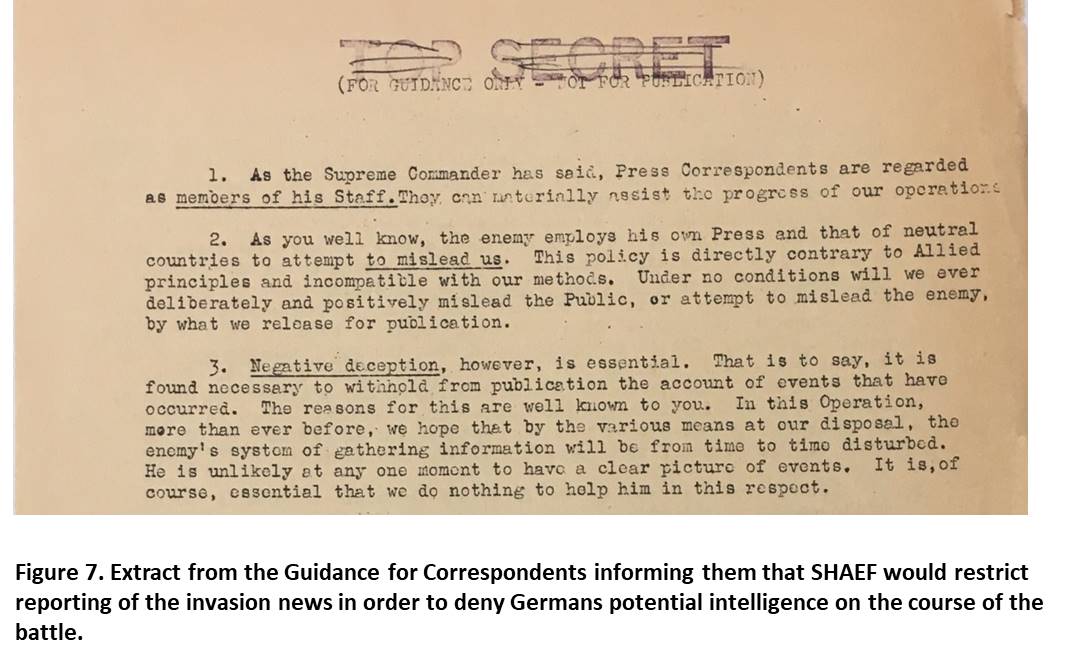 The Allies took vigorous steps to preserve this deception not just up until but even after the Normandy landings took place. One of the less recognized steps was the denial of open-source intelligence to the Germans — a tactic known as “Negative Deception” by SHAEF.[5] (Figure 7) In other words, the news outlets would not be permitted to give the game away. Eisenhower often spoke eloquently and honestly about the role of a free press in western democracies, but he wasn’t about to embark on a suicide pact with them.
The Allies took vigorous steps to preserve this deception not just up until but even after the Normandy landings took place. One of the less recognized steps was the denial of open-source intelligence to the Germans — a tactic known as “Negative Deception” by SHAEF.[5] (Figure 7) In other words, the news outlets would not be permitted to give the game away. Eisenhower often spoke eloquently and honestly about the role of a free press in western democracies, but he wasn’t about to embark on a suicide pact with them.
•
A wide array of incidents, some accidental, some clearly not so accidental, conspired to choke off the vast majority of reporting from the beaches, so much so that press agencies were in a nearly mutinous state by the end of the first week following the invasion. The twice-daily SHAEF press communiqués revealed virtually nothing. The morning communiqué for 7 June, for example, contained just three lines on the ground operations; the evening communiqué offered just eight vague lines. Forty-eight hours into the invasion and SHAEF had mentioned just a single location in relation to ground fighting: Caen.
LIFE‘s own 19 June edition (available on newsstands on June 12) exemplified this clampdown. In its unsigned lead-in to the feature story highlighting Capa’s photos, LIFE noted that most of the news the magazine was reporting of the actual fighting was coming from German sources. (Figure 8, top highlight) The article also noted that the Germans were threatening “to stop giving out news unless the Allies gave out more news.” (Figure 8, bottom highlight) Which is something the Allies were not going to do any more than was necessary. [Editor’s note: According to Capa biographer Richard Whelan, “Dennis Flanagan, the assistant associate editor who wrote the captions and text that accompanied Capa’s images in LIFE, recalls that he depended on the New York Times for background information, and for specifics he interpreted what he saw in the photographs.” — A.D.C.]
It is important to recognize two points regarding the Allied deception. First, while the German soldiers fighting for their lives in Normandy soon understood the import of the invasion, the “Fortitude South” deception was targeting the minds of the German high command in Berlin. The “reality” contained in Allied and neutral newspapers, arriving through embassies in neutral countries, seemed far more tangible than the frantic and confused reports coming from Field Marshals Gerd von Rundstedt and Erwin Rommel, the two principal German leaders in France, both of whom had previously run afoul of Hitler and were rapidly falling out of favor in the wake of the invasion.
And secondly, the Allied deception did not have to be perfect. It merely had to cause enough doubt to impede German reactions. As long as German decisions were based on events that had happened days or weeks previously, or anticipations of something to come, rather than current battlefield developments, the Allies would hold the initiative and advantage.
The Allies had a number of topics they absolutely wanted to keep concealed from the Germans, what we now would term Essential Elements of Friendly Information. While this list varied somewhat over time, three items were usually included. 1) Any speculation concerning whether there would or would not be additional landings (i.e., Pas de Calais); 2) mention of the assignment and location of senior commanders (i.e., Patton, and by extension his phantom army poised for the equally phantom Pas de Calais landing); and 3) the force list for the Normandy landings (i.e., the strength and combat power committed to the landings).[8]
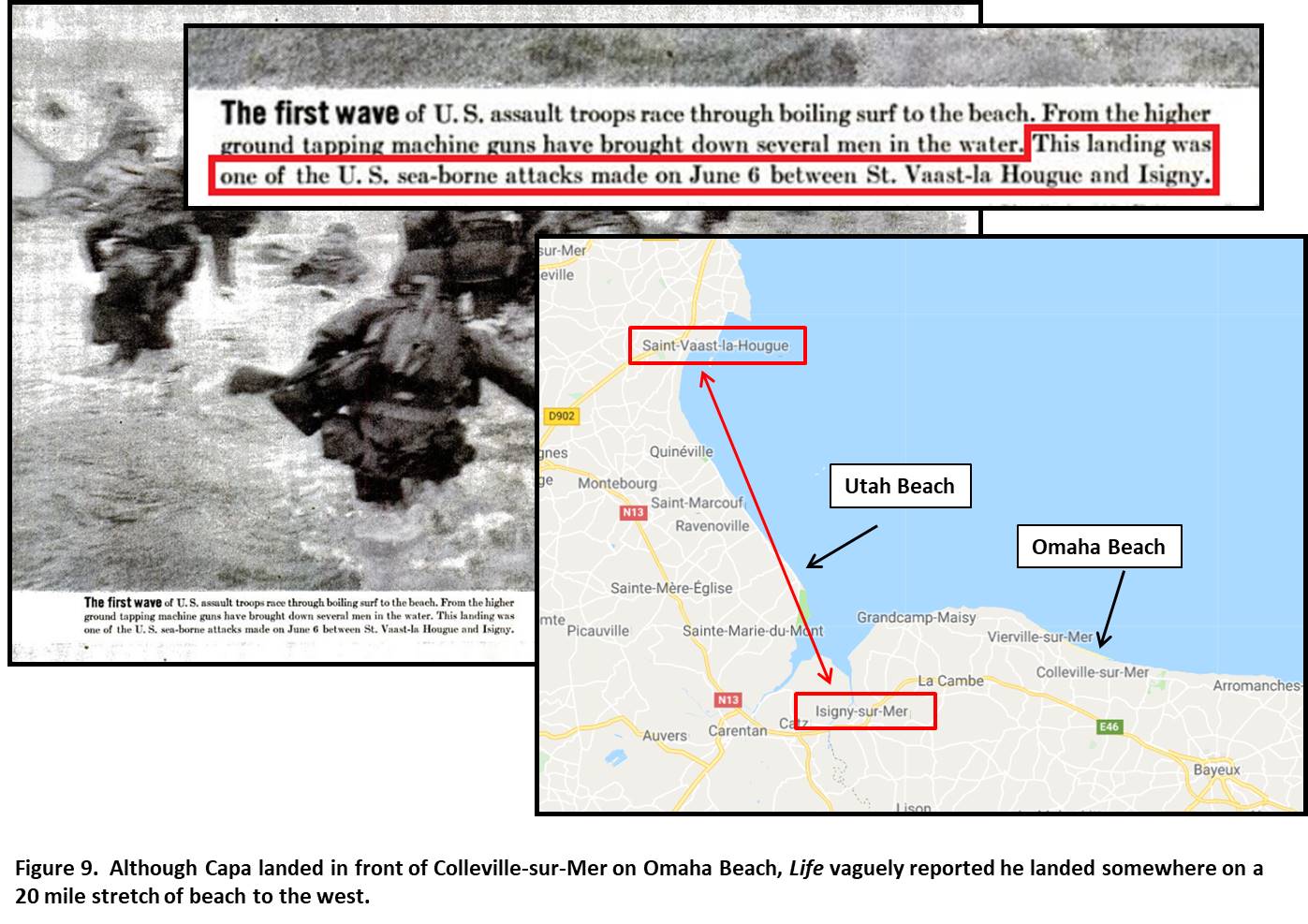 LIFE — and Morris — were willing participants in this deception effort. LIFE‘s 19 June issue featuring Capa’s D-Day photos obligingly displaced his landing site to a 20-mile-wide area that, in part, extended far past the westernmost Allied beachhead. (Figure 9) And despite a ban on unauthorized speculation regarding additional landings, both the 19 and 26 June LIFE issues were permitted to hint at just that in what could only be intentional, controlled leaks. (Figures 10 and 11) LIFE was not merely putting up with censorship, but actively being used in the “Fortitude South” deception effort.
LIFE — and Morris — were willing participants in this deception effort. LIFE‘s 19 June issue featuring Capa’s D-Day photos obligingly displaced his landing site to a 20-mile-wide area that, in part, extended far past the westernmost Allied beachhead. (Figure 9) And despite a ban on unauthorized speculation regarding additional landings, both the 19 and 26 June LIFE issues were permitted to hint at just that in what could only be intentional, controlled leaks. (Figures 10 and 11) LIFE was not merely putting up with censorship, but actively being used in the “Fortitude South” deception effort.
It was the third category above — that of the combat power employed — which particularly interests us. A look at Capa’s surviving film is revealing as much for what it does not show as for what it does show. It does not show anything of the size, scope and power of the invasion, clues to which the Germans would be searching for in the Allied press.
Recall that not a single Capa photo survives from the time he boarded his landing craft until the ramp dropped as it beached. No naval gunfire. No air attacks. No rocket-firing landing craft. No view of the endless waves of landing craft heading to shore. No hint of the mighty fleet disgorging power. The traditional excuse has been that it was too dark to take photographs until just before he landed at 0630 hours, but the reality is that he landed at 0820 hours, and sunrise had come at 0558 hours.[9] He had plenty of light, as did Coast Guard Chief Photographer’s Mate Robert Sargent, who took excellent photos of his own landing 40 minutes earlier on that very same beach sector. It is inconceivable that Capa could have been so poor a war photographer that he neglected to take a single picture of that awesome spectacle during his ride to the beach.
His landing photos are equally unrevealing. A relatively small number of men making their way uncertainly ashore, with no progress apparent beyond the shoreline. And after he stepped into the surf his photos are arguably worse. From the moment he got his feet wet until he boarded LCI(L)-94, not a single one of his photos showed fighting ashore, which was, after all, what the landings were all about. Every single surviving shot was focused more or less off-shore, seemingly showing men pinned down and unable to advance, wounded crawling in the surf, wrecked landing craft, and a sense of stagnation and inertia.
And once he boards LCI(L)-94 the record is equally thin. He took two shots of the receding beach, again apparently showing an invasion foundering at the shoreline. Then there was a pair of photos, one aimed to the west, the other to the east, showing an amazing absence of landing craft. Then came two photos of LCI(L)-94 sailors treating a fatally wounded crewman, followed by a third showing another wounded crewman being transferred to another landing craft.
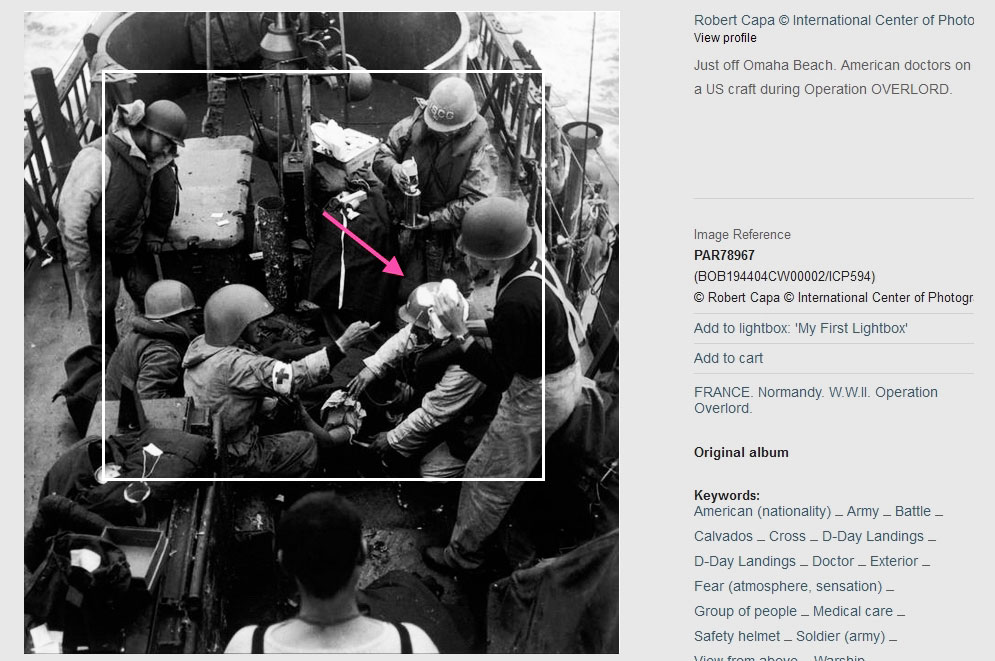
Robert Capa, “Untitled (Medics at Omaha Beach, June 6, 1944).” Annotated screenshot from magnumphotos.com. Victor Haboush indicated by red arrow.
•
Upon Capa’s arrival back aboard the USS Samuel Chase, the ostensibly sorry tale continued. Two photos of corpses, a photo of the mortally wounded LCI(L)-85 with its decks crammed with casualties, and finally a single photo of the last Chase troops loading a landing craft.
Think of that. Of his eleven known photos taken after leaving the beach, six featured the dead or dying (one of which also featured a sinking landing craft), two showed an invasion apparently stalled at the waterline, and two seemed to show the Allies hadn’t brought much in the way of an invasion fleet.
Capa’s surviving photos gave no evidence of the onslaught that had hit the beaches, and instead would raise doubt about the strength and significance of the landings. In short, they were precisely the kind of images the Allies wanted the Germans to see. And there’s small chance that was a matter of coincidence. With the deconstruction of Morris’s darkroom-accident fable, we know it was not a technical error that so thoroughly decimated Capa’s D-Day film, so we must look to other causes. And the only remaining likely agent of loss would have been the censor. …
•
Notes:
[1] Jozefa Stuart’s interview notes with John Morris. [Editor’s note: In the early 1960s Cornell Capa commissioned Jozefa Stuart to conduct a series of interviews, apparently toward a biography of Robert Capa that never materialized. — A.D.C.]
[2] Richard Whalen’s Capa, for instance. P. 214.
[3] Although Whelan drew on Jozefa Stuart’s interview with Morris, going so far as to quote specific parts of it, he omitted these key times and collapsed the sequence to make it appear to take place over a much shorter period.
[4] John Morris, Get the Picture, p. 6.
[5] SHAEF Public Relations Division, Guidance to Correspondents, dated 6 June 1944.
[6] Within six weeks of D-Day, both of the two principal German commanders would be gone. Field Marshal Gerd von Rundstedt, commander in chief of German forces in the west at the time of D-Day, had a checkered history with Hitler. He had been relieved of command in Russia for cause in late 1941, but recalled to command in the west in March, 1942. Von Rundstedt would be relieved from command in the west less than a month after D-Day. He was again named to head the German forces in the west on 1 September 1944, and again relieved in March 1945. Field Marshal Erwin Rommel was commander of Army Group B at the time of D-Day. As such he was von Rundstedt’s subordinate, and was responsible for defense of the invasion beaches. After several clashes with Hitler and being transferred from the deteriorating North African campaign in March, 1943, Rommel held a succession of important but secondary positions. Although called upon to prepare defenses against the looming invasion of France, he had insufficient time, manpower and resources. His disagreements with Hitler over the conduct of the Normandy campaign flared as early as 17 June 1944. A month later he would be seriously wounded and, soon after that, implicated in the plot against Hitler.
[7] Essential Elements of Friendly Information: “Key questions likely to be asked by adversary officials and intelligence systems about specific friendly intentions, capabilities, and activities, so they can obtain answers critical to their operational effectiveness. Also called EEFI.” (U.S. Department of Defense)
[8] See, for example, SHAEF Public Relations Division memo, Subj: Censorship Rulings on Initial Communique (amended), dated 5 June 1944.
[9] This fiction originated with Capa’s narrative in Slightly Out of Focus. In this passage (p. 139) he remarked that just as they were about to land, “it was now light enough to start taking pictures.” This, however, is merely an outgrowth of his fiction that he landed at 0630 hours with the first wave of Infantry.
•
Text copyright © 2019 by Charles Herrick. All rights reserved.
•
(For an index of links to all posts in this series, click here.)
•
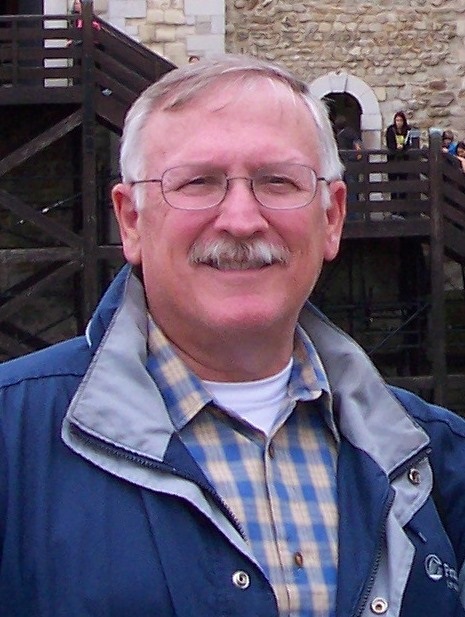 Charles Herrick joined the U.S. Army in 1970 and graduated from the U.S. Military Academy at West Point in 1974. Commissioned in the Infantry, he earned the Ranger tab and Master Parachutist’s wings. He served in a variety of positions from company grade officer to the Pentagon. He earned the Combat Infantryman’s badge while assigned as the Operations Officer of the 193rd Infantry Brigade in Panama in 1989, and later graduated from the U.S. Army War College.
Charles Herrick joined the U.S. Army in 1970 and graduated from the U.S. Military Academy at West Point in 1974. Commissioned in the Infantry, he earned the Ranger tab and Master Parachutist’s wings. He served in a variety of positions from company grade officer to the Pentagon. He earned the Combat Infantryman’s badge while assigned as the Operations Officer of the 193rd Infantry Brigade in Panama in 1989, and later graduated from the U.S. Army War College.
Since retiring from the Army in 1996, Herrick has continued to work on defense issues as a contractor in East Asia, Latin America, the Balkans, Africa and Central Asia. He holds an MBA from the University of California at Los Angeles. He lives in California with his wife, where he pursues his passion for military history. To contact Charles Herrick, click here.


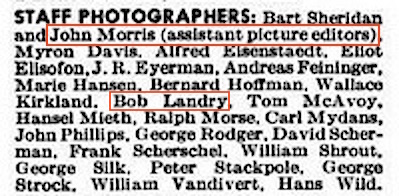
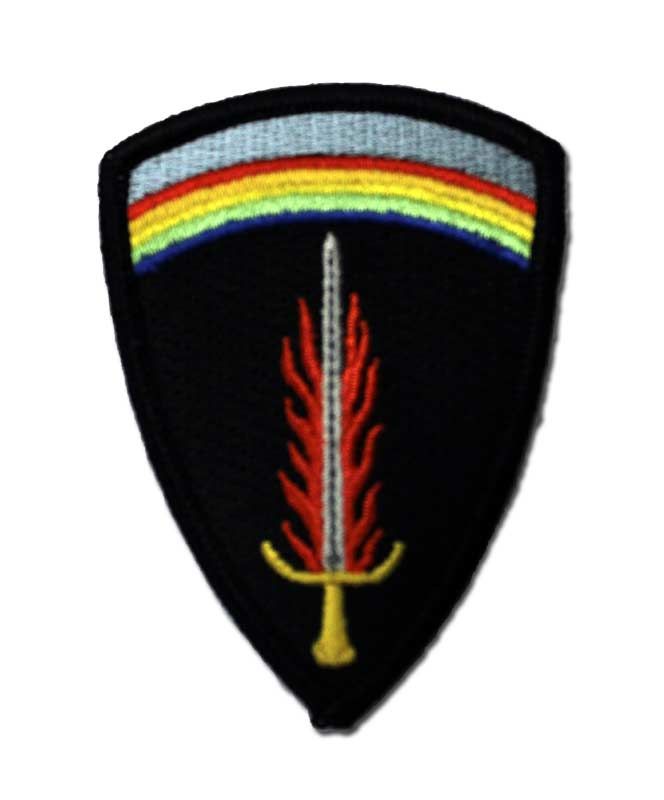
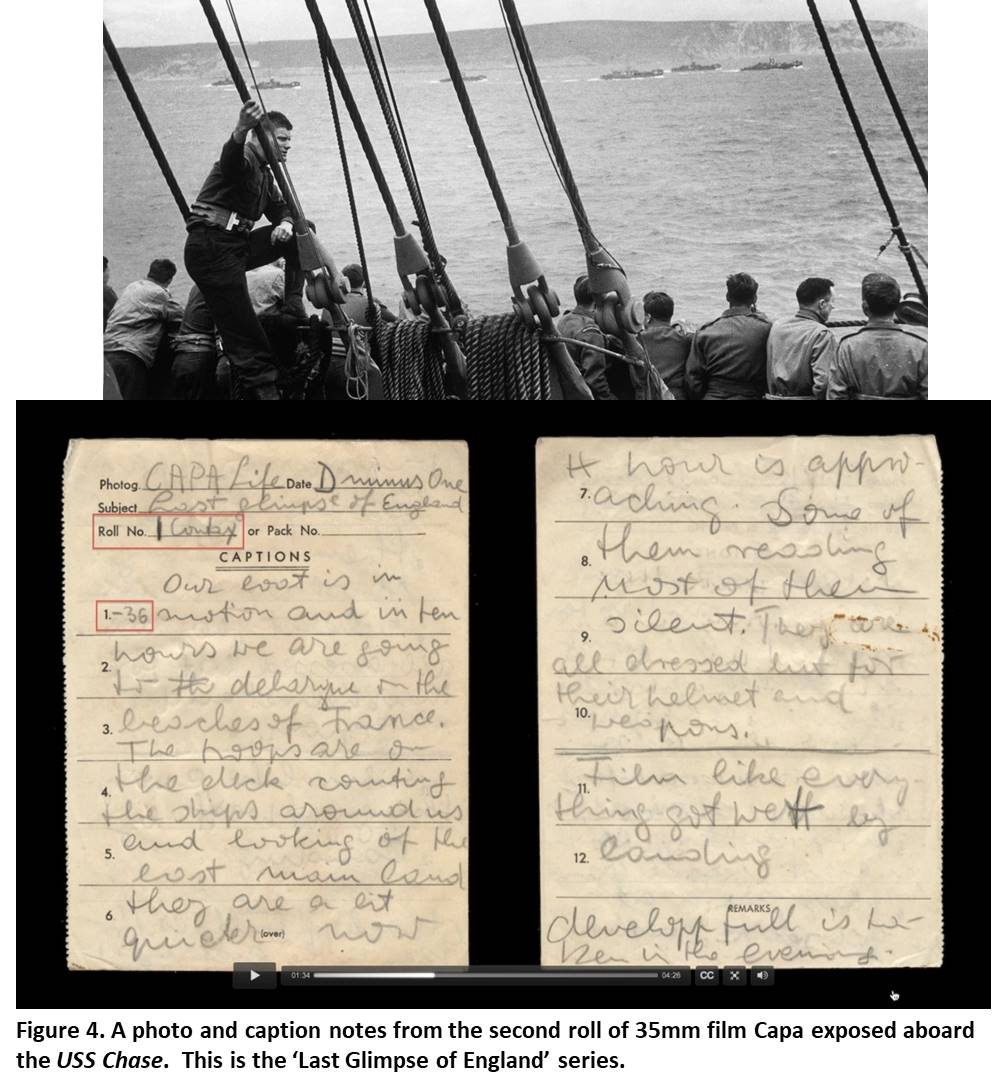
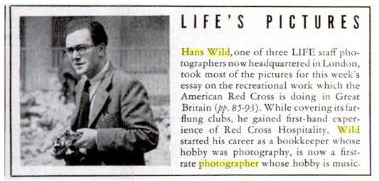
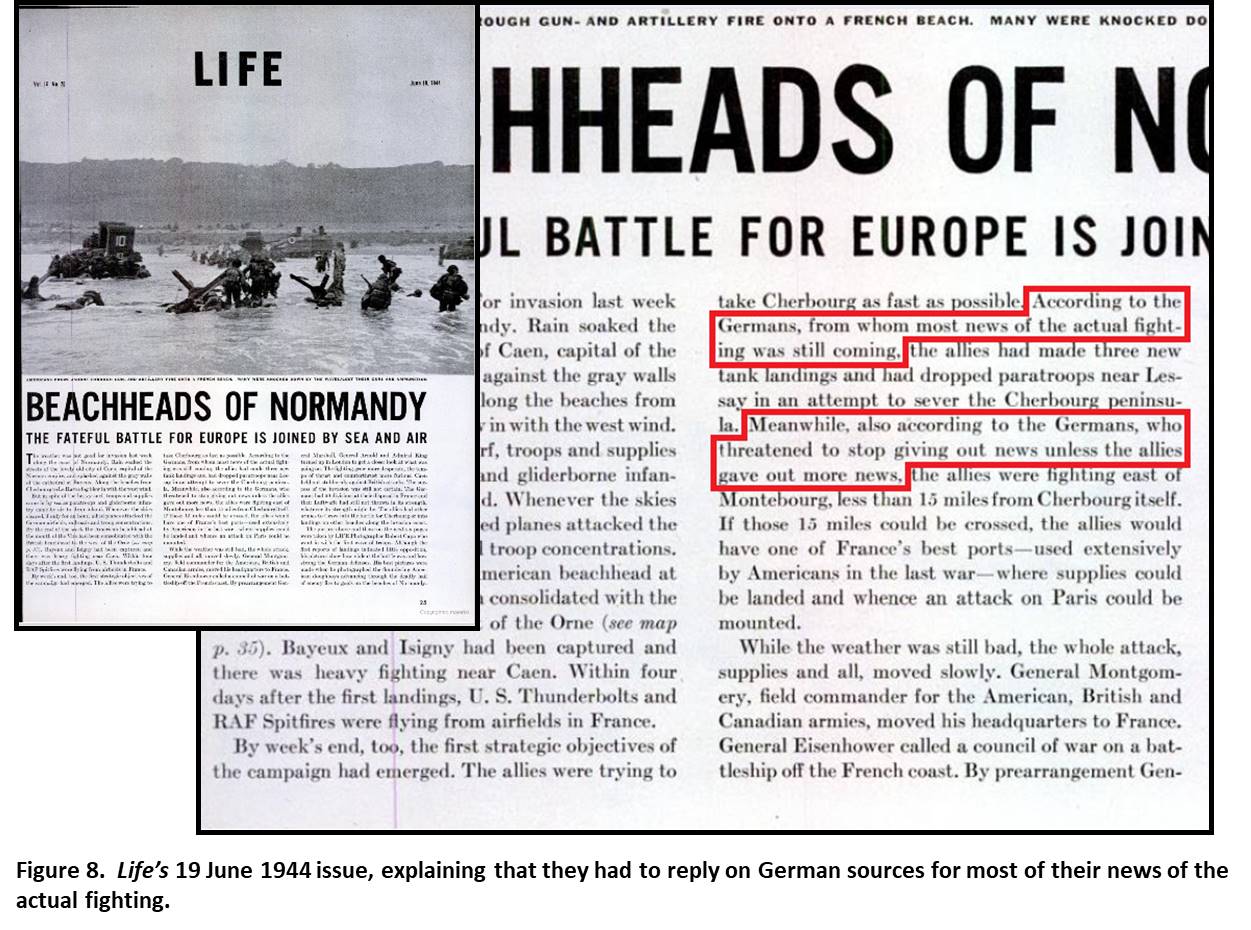
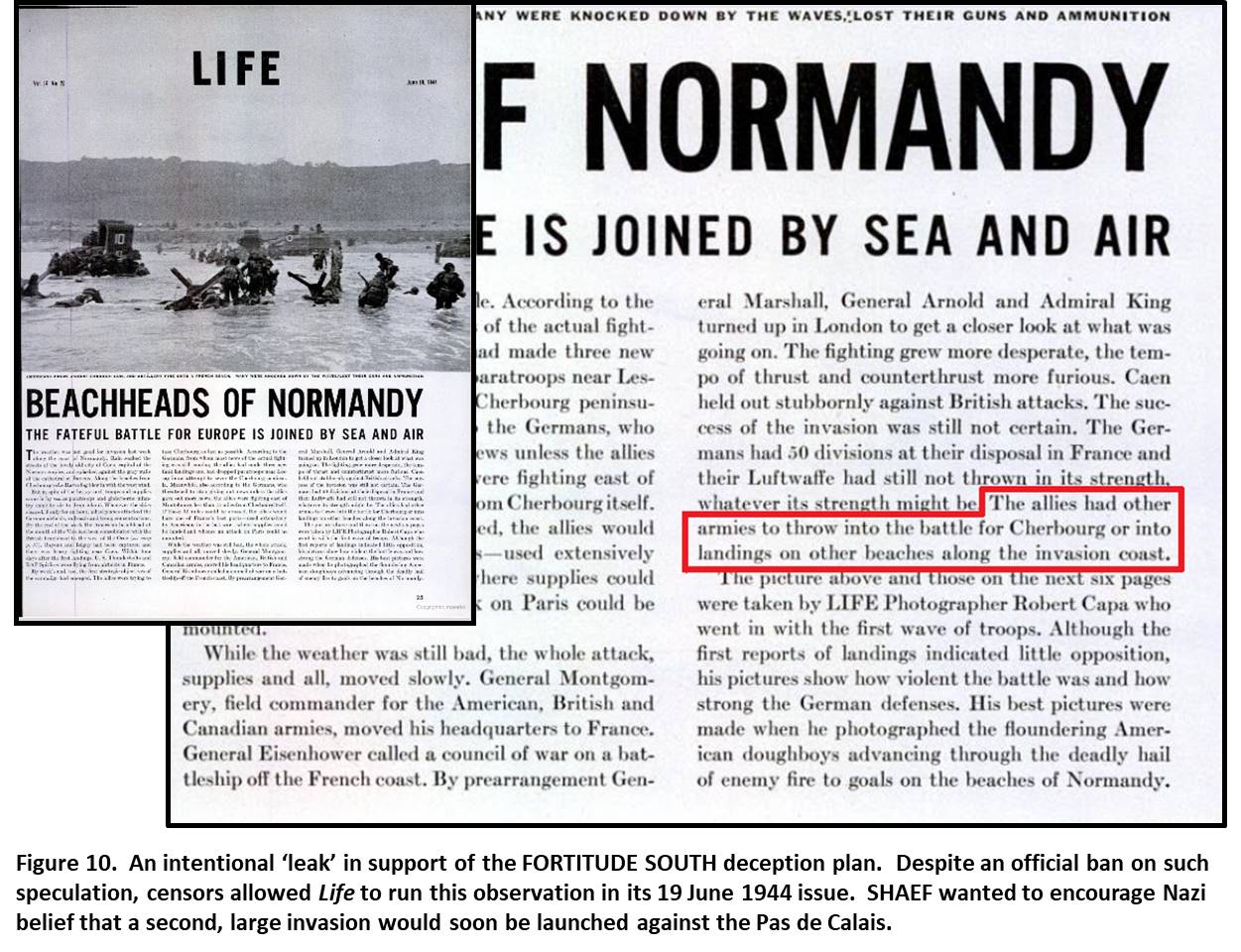
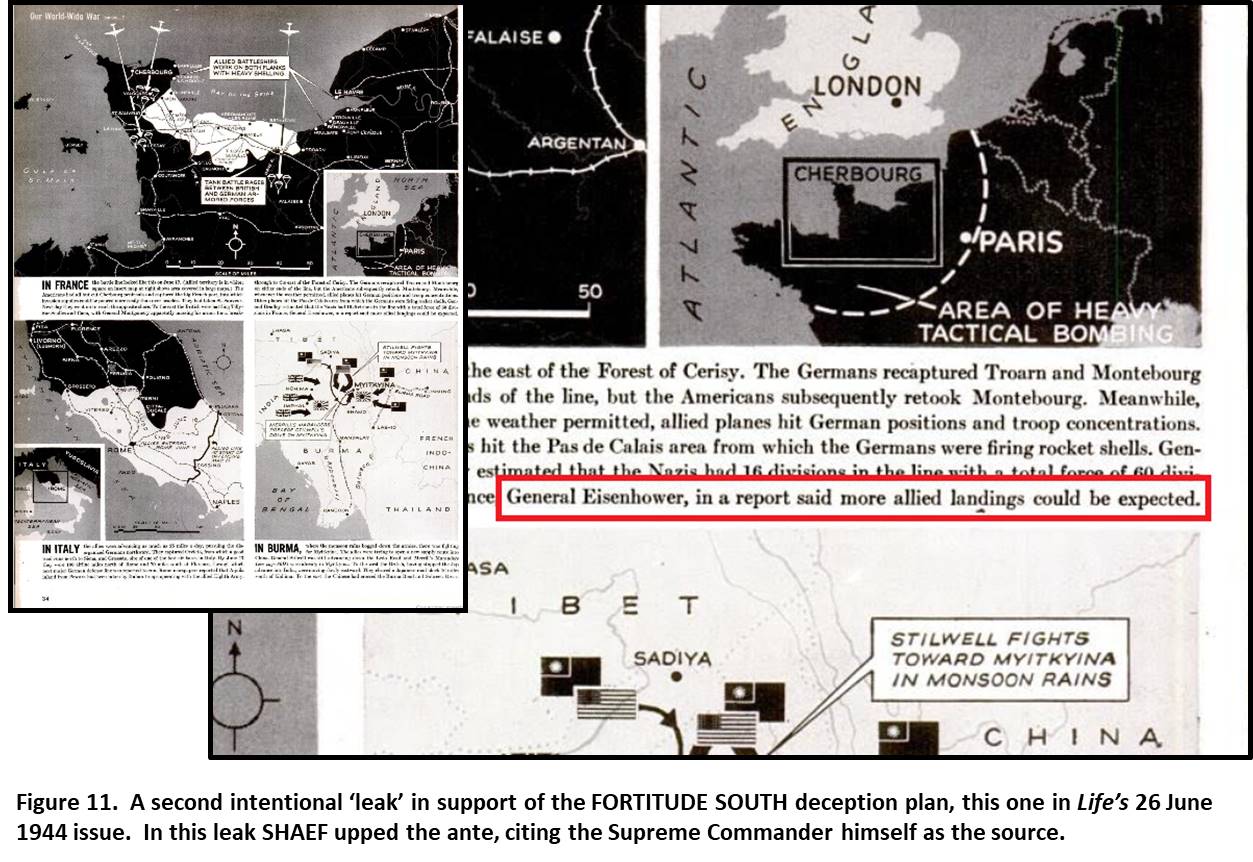
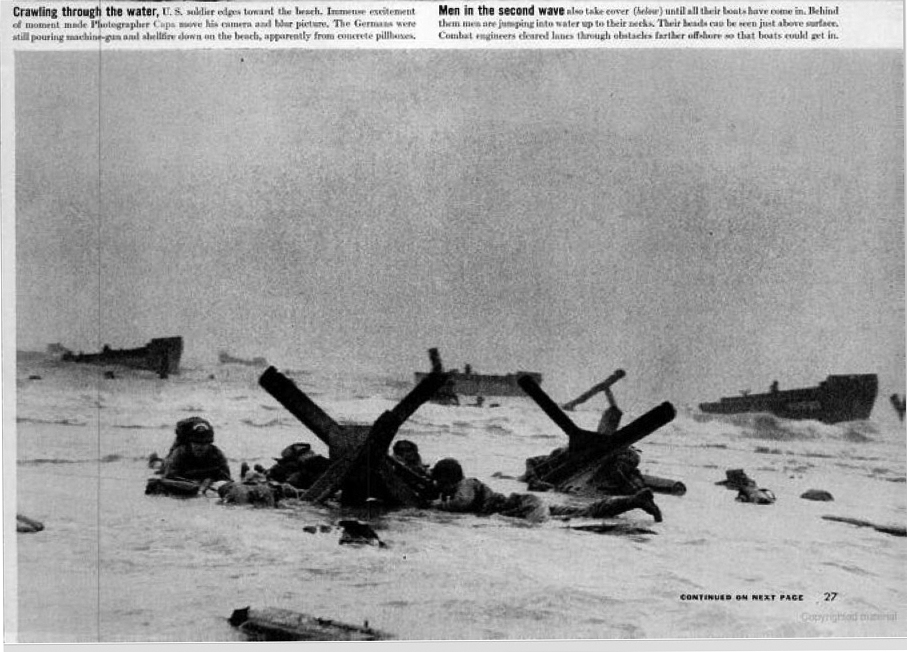
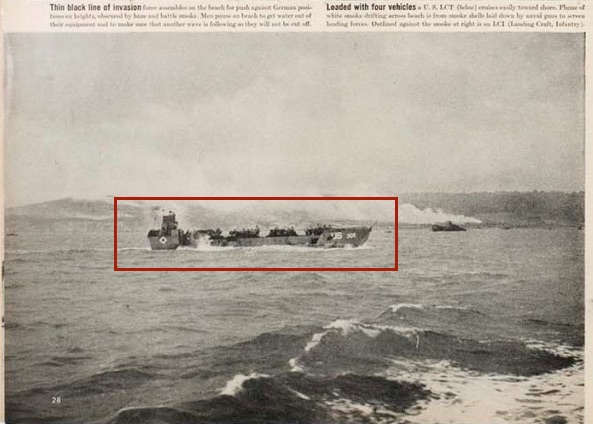




Leave a Comment